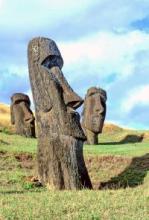In geography, the antipode of any place on Earth is the point on the Earth's surface which is diametrically opposite to it. Two points that are antipodal to each other are connected by a straight line running through the centre of the Earth. Considering that around 71% of the Earth's surface is covered in ocean, less than 4% of land is antipodal to land and most of India only corresponds to water, with one exception. The antipode of Jaisalmer in Rajasthan happens to be the legendary Easter Island, a relatively tiny land mass measuring 163 square kilometres. The island is also India's only antipode which does not lie on water.
Easter Island is a special territory of Chile which is located in the Pacific Ocean at the very edge of Polynesia. It is claimed to be the most remote inhabited island in the world and is famous for its monumental statues, called moai and is a UNESCO World Heritage Site. The moai were carved by the Rapanui people between 1100 and 1680 CE.
The Rapanui also boasted a pictographic script named Rongorongo. In 1932, a Hungarian by the name of Vilmos Hevesy created a sensation by claiming that Rongorongo was related to the Indus Valley script. This claim was, however, debunked a few years later. The Indus script is incidentally also linked by some Dravidian historians to Tamil. They consequently also believe that Rongorongo is related to Tamil which therefore implies the presence/migration of Tamils to Easter Island.
Proponents of the Kumarikandam/Lemuria hypotheses believe that a lost advanced Tamil culture resided on Easter Island circa 20,000 BCE.

